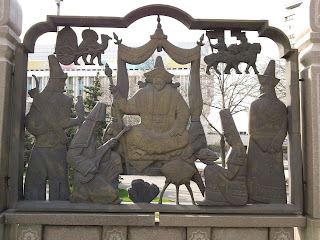By the mid-15th century, the successors to Genghis Khan's Mongol Empire had lost control of their territory, split up into numerous kingdoms across Central Asia. In the 1460s, the Kazakh Khanate was born when several "Kazakh" leaders joined together and broke away from the Uzbek-dominated khanate (or kingdom) of Abu'l-Khayr Khan . This is the first time in the historical record when we hear of the Kazakhs referring to themselves as such. There is some argument about the origin of this word, but the most likely explanation is that it comes from the Turkic word qazaq, which means "to wander." Thus the Kazakhs were wandering steppe herders and warriors.
The Kazakh khanate flourished in the middle ages and came to control the area that is now Kazakhstan as well as territory that extended into Southern Siberia and present-day Uzbekistan, Kyrgyzstan, and Turkmenistan. During this time, the Kazakhs controlled much of the Silk Road, including the important cities of Tashkent, Taraz, and Turkistan, all of which experienced a cultural renaissance during the period between the 15th and 18th centuries.
In the early 1600s, the Kazakh Khanate split into three "Juzes" or hordes. These were distinct political confederations--the Great, Middle, and Small Juzes--each of which had its own distinct geographic boundaries. At times the Juzes were united under a single leader (whom all three agreed to follow), but other times they had no common leader and were politically divided.
This panel depicts the beginning of the end of Kazakh dominance of Kazakhstan. Notice all of the mourners, as well as the people being taken as prisoners and slaves. The years of 1723-1727 are known in Kazakh history as "the years of Great Disaster." This was the beginning of repeated Dzungar (pronounced Jungar) incursions into Kazakhstan, which coincided with several years of famine and widespread illness across the steppes. The Dzungars were a nomadic people who arose in northwestern China and southwestern Mongolia in the 17th century. In the early 18th century, they pushed westward into Kazakhstan, plundering and destroying Turkistan and Tashkent in 1724-1725. The wars with the Dzungars continued for many years, and they will continue in our next panel.





